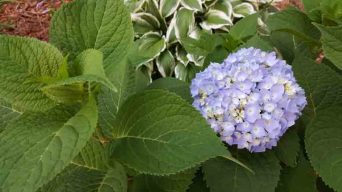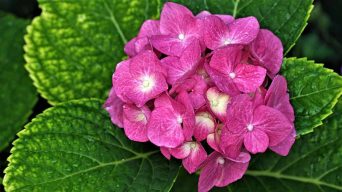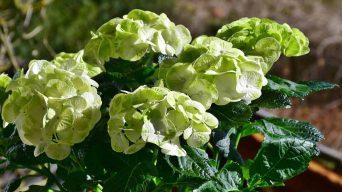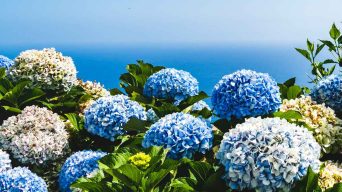Key Takeaways
- Hydrangea flowers can turn brown for various reasons, including water stress, pest infestation, fungal diseases, sunburn, and nutrient deficiencies.
- To fix brown hydrangea flowers, adjust watering techniques, apply pest control measures or fungicides when necessary, provide shade or shelter from harsh environmental conditions, and supplement nutrients through fertilization or pruning damaged blooms off regularly.
- Prevention is vital in preventing brown hydrangea flowers. Choose appropriate varieties for your soil type, maintain proper watering and fertilizing techniques, and prune damaged blooms promptly.
- When selecting the right hydrangea variety for your planting location, consider factors like climate, soil acidity, and sun exposure to ensure healthy growth and beautiful blooms all season long.
Gardeners belove hydrangeas for their lush foliage and vibrant blooms, but seeing those beautiful flowers turning brown can be disheartening.
This post will explore the common reasons behind browning hydrangea blossoms, from soil acidity issues to exposure to harsh elements.
Understanding the underlying causes and implementing practical solutions can restore your hydrangea plants’ health and vibrancy.
Reasons For Brown Hydrangea Flowers
Hydrangea flowers may turn brown for various reasons, such as water stress, pest infestation, fungal diseases, sunburn, and nutrient deficiencies.
Water Stress
Water stress is a leading cause of hydrangea flowers turning brown, affecting your plant’s appearance and overall health.
For example, if you’re overwatering your hydrangeas, smaller flowers may turn brown due to root rot and lack of oxygen.
On the other hand, under-watering puts immense stress on the entire plant, causing browning but also wilting and stunted growth.
Water only when the top two inches of soil feel dry to ensure your hydrangea thrives and maintains vibrant blooms throughout the season.
Remember that well-draining soil is crucial for preventing waterlogging while providing sufficient moisture at all times.
Pest Infestation
Pest infestations can wreak havoc on your beautiful hydrangea flowers, causing them to turn brown and wilt.
One common culprit is aphids, tiny insects that feed on plant sap, leading to the yellowing of leaves and stems and the potential transmission of diseases between plants.
To address pest infestations in your hydrangeas effectively, it’s essential first to identify which type of pest is causing the problem.
Carefully inspect your plants for any visible signs of these tiny intruders by examining both sides of the leaves and petals.
Once identified, you can employ targeted treatments such as insecticidal soap or horticultural oil sprays explicitly designed for combating these nuisances.
Fungal Diseases
Fungal diseases are a common culprit in causing hydrangea flowers to turn brown.
They affect not only the blooms but also the leaves and stems of your beloved plant.
One such fungal disease is powdery mildew, which appears as a white or grayish powder on the surface of leaves and can cause them to turn yellow and fall off prematurely.
As a plant owner, it’s essential to recognize these telltale signs early on so you can take appropriate action.
Avoid overhead watering to prevent fungal diseases from taking hold of your hydrangeas; target irrigation directly at the soil level instead.
Additionally, practice good garden hygiene by regularly removing fallen debris and dead foliage from around your plants—this will minimize sources of infection and make it more difficult for fungi to thrive.
Sunburn
Exposing hydrangea blooms to direct sunlight for prolonged periods can lead to sunburn, causing them to turn brown.
This may happen if the plant is not situated in a shaded area or is exposed to too much direct sunlight during the hottest part of the day.
To remedy this, providing artificial shade or covering the plant with cloth can protect it from getting scorched by the sun’s rays.
It’s also important to monitor environmental conditions and ensure your hydrangeas are planted in an appropriate spot where they receive enough light without excessive heat.
Nutrient Deficiencies
Brown hydrangea flowers can also occur due to nutrient deficiencies in the soil.
Without proper nutrients, hydrangeas will struggle to produce healthy blooms and leaves.
Phosphorus is a critical nutrient for blooming, so you’ll likely notice brown or spotty blooms without enough phosphorus in the soil.
To ensure your hydrangeas have the right balance of nutrients, you may need to supplement their diet with fertilizers high in phosphorus and low in nitrogen.
This will promote healthy blooming while avoiding excessive foliage growth that can lead to brown spots.
By promptly addressing nutrient deficiencies and providing balanced nutrition through fertilizer application and careful monitoring, you can keep your hydrangeas healthy and vibrant all season long.
Solutions For Brown Hydrangea Flowers
If your brown hydrangea flowers need fixing, you can adjust your watering techniques to ensure the plant gets enough moisture without overdoing it.
Additionally, apply pest control or fungicides if needed, provide shade or shelter, and supplement nutrients if deficiencies are found.
Finally, use anvil pruners to trim any damaged blooms.
Adjusting Watering Techniques
To fix brown hydrangea flowers, adjusting watering techniques is crucial.
Here are some tips to help revive your plant:
- Water deeply: Give your hydrangea a long, slow drink once or twice a week instead of frequent light watering.
- Mulch: Apply a layer of mulch around the base of the plant to help retain moisture in the soil and keep the roots cool.
- Check drainage: Make sure the soil is well-draining and not too compacted, as this can cause waterlogging, leading to root rot and browning leaves.
- Watering schedule: Water your hydrangea early in the morning or late in the evening to avoid evaporation caused by direct sunlight during peak hours.
- Monitor humidity levels: If you live in an area with low humidity levels, consider using a humidifier or placing a tray filled with pebbles and water underneath your plant.
- Avoid overhead watering: Wet flowers can develop fungal diseases quickly, so it’s best to use drip irrigation or water from below.
Applying Pest Control Measures
To prevent brown hydrangea flowers due to pest infestation, it is essential to apply appropriate pest control measures.
Here are some effective ways to control pests that may be causing brown hydrangea blooms:
- Insecticidal soap: Use an insecticidal soap solution to spray on the plant leaves and stems, targeting the areas where pests are present.
- Neem oil: Spray neem oil on the plant as a natural alternative to chemical pesticides. It works by disrupting the life cycle of pests.
- Horticultural oil: Apply horticultural oil on the plant to smother and suffocate insects that may be causing damage.
- Dusting sulfur: Sprinkle dusting sulfur around the base of the plant to deter pests from coming near it.
- Sticky traps: Place sticky traps near the plants to capture flying insects feeding on hydrangea blooms.
Using Fungicides
Using fungicides can be an effective solution to eliminate fungal diseases causing hydrangea flowers to turn brown.
Here are some tips for using fungicides on your hydrangeas:
- Choose a fungicide labeled for hydrangeas and the specific type of fungus causing the problem.
- Follow the instructions carefully, including how much to apply and when.
- Wear protective clothing, such as gloves and a mask, when applying the fungicide.
- Spray the foliage thoroughly, covering both sides of the leaves and all parts of the plant affected by the fungus.
- Reapply the fungicide according to the instructions on the label or as necessary until you see improvements in your hydrangea’s health.
Remember that prevention is always better than cure for fungal diseases in plants.
Avoid watering your hydrangeas from above, keep garden debris cleaned up, and prune any damaged or diseased branches promptly.
With proper care and treatment, your hydrangeas can remain healthy and produce beautiful blooms year after year.
Providing Shade Or Shelter
If your hydrangea flowers turn brown, it could be due to excessive exposure to sunlight or wind.
Providing shade or shelter can help prevent this issue.
Here are some tips:
- Use a cloth or shade cloth to provide temporary shade during the hottest parts of the day.
- Plant your hydrangeas in an area that is protected from strong winds.
- Plant taller plants nearby to act as natural windbreakers.
- Place potted hydrangeas in locations with partial shade.
Supplementing Nutrients
To prevent your hydrangea flowers from turning brown, it’s essential to supplement nutrients.
Here are some ways to do that:
- Apply a slow-release granular fertilizer during the early spring or fall to nourish the plant with essential nutrients gradually.
- Sprinkle Epsom salt around the base of the hydrangea bush. Epsom salt is rich in magnesium and sulfate, which promotes plant growth, enhances flower blooming, and prevents brown spots on leaves.
- Add coffee grounds to your soil mix. Coffee grounds are rich in nitrogen and acidic properties that enhance soil acidity levels, which makes the soil suitable for hydrangeas.
- Use compost as a natural source of nutrients by mixing organic materials such as leaves, kitchen waste, and manure into the soil.
- Supply iron-rich fertilizers such as chelated iron or iron sulfate to fix chlorosis (yellowing leaves) caused by nutrient deficiency.
Pruning Damaged Blooms
If your hydrangea blooms have turned brown, it may be time to prune the damaged buds.
Here are some steps you can take:
- Use clean anvil pruners to remove the damaged blooms. Make sure to sterilize the blades with rubbing alcohol before use.
- Find the deadhead location where the dead bloom meets the next set of leaves.
- Cut the stem above the deadhead location at a 45-degree angle.
- Be careful not to prune too hard, damaging healthy buds and affecting future blooming.
- Dispose of any diseased plant material in a sealed bag or burn it to prevent the spreading of fungal diseases.
Remember that brown hydrangea buds will not bloom, so it is important to address them promptly.
Pruning damaged blooms is one step towards preventing further browning and ensuring a healthy growth for your hydrangea plant.
Preventing Brown Hydrangea Flowers
To avoid brown hydrangea flowers in the future, it’s crucial to choose compatible varieties based on your soil type and use proper watering and fertilizing techniques.
Additionally, it is advisable to monitor the surrounding environmental conditions and prune any damaged blooms regularly.
Following these steps, you can ensure your hydrangeas remain healthy and vibrant while avoiding unsightly and unappealing brown flowers.
Choosing Appropriate Hydrangea Varieties
When selecting the right hydrangea variety, it’s important to consider factors like climate, soil acidity, and sun exposure.
For instance, mophead hydrangeas (also known as Hortensia or French hydrangea) thrive in neutral to acidic soils where they can produce pink or blue flowers.
Meanwhile, panicle hydrangeas do well in direct sunlight and tolerate drought better than other types of hydrangeas.
The endless summer and summer crush varieties are excellent for long-lasting blooms from spring until fall.
Planting In Proper Soil
Choosing the right soil for your hydrangeas is crucial in preventing brown flowers.
Hydrangeas prefer a well-draining, rich soil that is slightly acidic with a pH between 5.2 and 6.0.
If your soil is too alkaline, your plant may not be able to absorb essential nutrients, resulting in poor growth and brown flowers.
To increase acidity levels, you can amend the soil by adding topsoil or compost.
It’s also vital to ensure good drainage around your plant’s root system to prevent waterlogging, leading to root rot and browning of leaves and flowers.
To improve drainage, add perlite or sand into your planting hole before setting in the hydrangea root ball, then backfilling with the amended soil mixture until leveled off or raised just above ground level if needed.
Maintaining Proper Watering And Fertilizing
Proper watering and fertilizing are crucial to keeping your hydrangea flowers healthy and vibrant.
Aim to water deeply every few days in hot weather or when rainfall is scarce, making sure your plant’s roots receive adequate moisture without excess standing water.
Over or underwatering can cause the shrubs to weaken and turn brown.
Consider supplementing nutrients throughout the growing season with a balanced fertilizer low in phosphate but high in potassium.
Fertilizer burn can also cause the edges of leaves and flower buds to turn brown, so it’s important not to overfertilize.
Monitoring Environmental Conditions
One of the crucial ways to prevent brown hydrangea flowers is by monitoring the plant’s environmental conditions.
This includes ensuring the plant receives enough water regularly, especially during hot and dry weather.
Providing proper shade is also essential, as too much direct sunlight can cause stress on the plant and result in brown leaves or flowers.
Planting nearby trees or using cloth covers can provide sufficient shade for your hydrangea shrubs.
Additionally, avoiding overcrowding and maintaining good air circulation will help reduce disease incidence that could cause brown spots on the leaves or blooms.
Final Thoughts
If your hydrangea flowers are turning brown, there could be several reasons.
But don’t worry; with the right care and attention, you can fix the problem and enjoy beautiful blooms all season.
To keep your plants healthy, it’s important to regularly check the soil’s acidity, adjust watering as necessary, and take measures to prevent pest infestations.
Additionally, you should shield your plants from excessive sun and wind exposure and give them the necessary nutrients and pruning when required.







